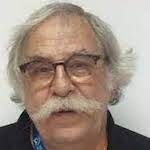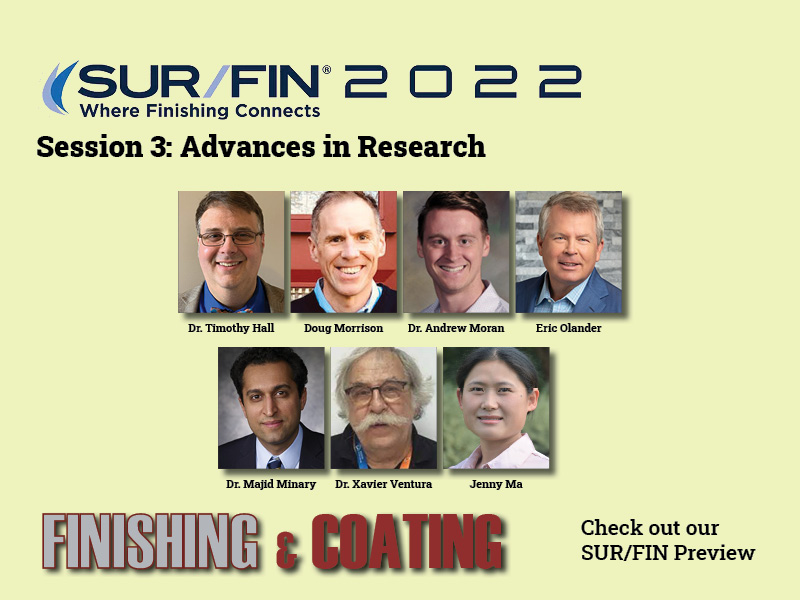Session 3 at the NASF SUR/FIN Technical Conference will be on “Advances in Research.”
Here are the abstracts for the presentations. Please visit www.nasfsurfin.com for information on registering for the event:
Session 3: Advances in Research
Session Chairs Dr. Jim Lindsay, NASF, and Dr. Tim Hall, Faraday Technology
8:30 – 9:00: Electrochemical Finishing of Mo Feedhorn Arrays — Dr. Timothy Hall, Faraday Technology
 Dr. Timothy HallThis paper will discuss recent developments toward the demonstration of a process to electrochemically finish the feedhorn arrays produced with Mo by EBM additive manufacturing. Specifically, we will discuss developments toward achieving optimal electrochemical processing conditions, surface finish, nominal tooling, and performance. Unlike conventional surface finishing processes that either use media or machine tools to physically modify the surface, electrochemistry can be used as a non-contact flexible approach, to finish hard to reach surfaces such as the internal channels of refractory materials that may be inaccessible to conventional processes. This paper will focus on pulse/pulse reverse electrofinishing processes developed by Faraday Technology and the technique to scale this approach to functional parts of interest.
Dr. Timothy HallThis paper will discuss recent developments toward the demonstration of a process to electrochemically finish the feedhorn arrays produced with Mo by EBM additive manufacturing. Specifically, we will discuss developments toward achieving optimal electrochemical processing conditions, surface finish, nominal tooling, and performance. Unlike conventional surface finishing processes that either use media or machine tools to physically modify the surface, electrochemistry can be used as a non-contact flexible approach, to finish hard to reach surfaces such as the internal channels of refractory materials that may be inaccessible to conventional processes. This paper will focus on pulse/pulse reverse electrofinishing processes developed by Faraday Technology and the technique to scale this approach to functional parts of interest.
9:00 – 9:30: A Job Shop Adopts Safe Chrome — Doug Morrison, Trion Coatings
 Doug MorrisonTrion Coatings has developed an electrochemical coating process called SAFE Chrome®. This process replaces toxic and carcinogenic hexavalent chromium with an environmentally friendly and SAFE alternative. SAFE Chrome improves the wear resistance, hardness, and corrosion resistance of steel substrates and expands their performance and range of application. Job Shops seeking hexavalent chrome replacement have had limited options prior to the launch of SAFE Chrome. This presentation will provide a real world case study that details the operational ease of transition and cost benefits associated with transition from hexavalent chromium to SAFE Chrome adoption.
Doug MorrisonTrion Coatings has developed an electrochemical coating process called SAFE Chrome®. This process replaces toxic and carcinogenic hexavalent chromium with an environmentally friendly and SAFE alternative. SAFE Chrome improves the wear resistance, hardness, and corrosion resistance of steel substrates and expands their performance and range of application. Job Shops seeking hexavalent chrome replacement have had limited options prior to the launch of SAFE Chrome. This presentation will provide a real world case study that details the operational ease of transition and cost benefits associated with transition from hexavalent chromium to SAFE Chrome adoption.
9:30 – 10:00: Chrome Deposition from a Reach Compliant Trivalent Chromium Chemistry — Dr. Andrew Moran, Faraday Technology
 Dr. Andrew MoranTrivalent chromium is a potential environmentally-friendly alternative to toxic hexavalent chromium in electroplating operations. However, the use of trivalent chromium chemistries is hampered by poor performance of electroplated parts. Regardless, increasing interest in the use of trivalent chromium as a replacement for hexavalent chromium is being facilitated by regulations banning or restricting the use of hexavalent chemistries. In this talk, Faraday will present results from its development programs and discuss the similarities between chrome deposits from conventional hexavalent chromium and from the REACH compliant trivalent chemistry. Specifically, Faraday will discuss the effect of processing conditions and pulse-reverse electrodeposition on microstructure and wear resistance of trivalent chromium coatings as well as evaluating its potential for a hexavalent chromium free plating shop.
Dr. Andrew MoranTrivalent chromium is a potential environmentally-friendly alternative to toxic hexavalent chromium in electroplating operations. However, the use of trivalent chromium chemistries is hampered by poor performance of electroplated parts. Regardless, increasing interest in the use of trivalent chromium as a replacement for hexavalent chromium is being facilitated by regulations banning or restricting the use of hexavalent chemistries. In this talk, Faraday will present results from its development programs and discuss the similarities between chrome deposits from conventional hexavalent chromium and from the REACH compliant trivalent chemistry. Specifically, Faraday will discuss the effect of processing conditions and pulse-reverse electrodeposition on microstructure and wear resistance of trivalent chromium coatings as well as evaluating its potential for a hexavalent chromium free plating shop.
10:00 – 10:30: New Revolutionary Buffer/Brightener System for Bright Watt’s Nickel and Sulfamate Nickel — Eric Olander, EPI
 Eric OlanderNew, revolutionary Watt’s bright nickel process that is formulated with a proprietary buffer/brightener chemistry that eliminates using boric acid for the buffer. The proprietary buffer/brightener system changes the parameters of running a Watts bright nickel process. Carboxylic acids constitute first generation of boric acid replacement, which are characterized by an excellent buffer capacity, but, unfortunately, lack the well-known leveling power of traditional bright Watt’s nickel electrolytes. It is believed that the loss of leveling results from the saturation of the co-ordinate sphere of nickel by such carboxylic acids excluding, thereby, a direct interaction of so-called brighteners and levelers with Watt’s nickel. These advancements in the parameters change the resulting Watts bright nickel bath in brightness/gloss, metal distribution, and handling of contamination concerns. The proprietary buffer system drives the process working synergistically with the proprietary brightener system. The new process is proven in production for rack and barrel processes in the European Union and is manufactured in Switzerland. This new proprietary buffer for Watt's bright nickel processes has not been evaluated in semi-bright nickel nor microporous nickel. The proprietary buffer system works extremely well in sulfamate nickel processes resulting in some of the same advancements as in the Watt’s bright nickel process.
Eric OlanderNew, revolutionary Watt’s bright nickel process that is formulated with a proprietary buffer/brightener chemistry that eliminates using boric acid for the buffer. The proprietary buffer/brightener system changes the parameters of running a Watts bright nickel process. Carboxylic acids constitute first generation of boric acid replacement, which are characterized by an excellent buffer capacity, but, unfortunately, lack the well-known leveling power of traditional bright Watt’s nickel electrolytes. It is believed that the loss of leveling results from the saturation of the co-ordinate sphere of nickel by such carboxylic acids excluding, thereby, a direct interaction of so-called brighteners and levelers with Watt’s nickel. These advancements in the parameters change the resulting Watts bright nickel bath in brightness/gloss, metal distribution, and handling of contamination concerns. The proprietary buffer system drives the process working synergistically with the proprietary brightener system. The new process is proven in production for rack and barrel processes in the European Union and is manufactured in Switzerland. This new proprietary buffer for Watt's bright nickel processes has not been evaluated in semi-bright nickel nor microporous nickel. The proprietary buffer system works extremely well in sulfamate nickel processes resulting in some of the same advancements as in the Watt’s bright nickel process.
10:30 – 11:00: Fabrication of Cermets Using Electroplating of Metal Into Ceramic Scaffold — Majid Minary, Arizona State University
 Dr. Majid MinaryIncreased use of hydrogen is projected to be one of the main routes toward the goal of achieving cleaner environment. One of the most efficient methods to produce hydrogen is using electrolyzers, which are currently costly to produce. As such, only ~ 2% of the hydrogen currently is produced using electrolyzers. Similarly, hydrogen is the main fuel for fuel cells that are considered for clean transportation and distributed power applications. New low-cost and scalable manufacturing processes that bring down the cost of electrolyzers are attractive. We are exploring using electrodeposition to fabricate cermets (metal-ceramic composites) for electrodes in solid oxide fuel cells (SOFCs) and solid oxide electrolysis cells (SOECs) (anode in SOFC and cathode in SOEC). We are exploring various electrodeposition modes including pulsed current and direct current with different parameters to infiltrate metals including Cu and Ni into porous ceramic scaffolds. Currently, fabrication of such electrodes is done using casting, screen printing, spin coating, and impregnation. However, these processes are not efficient, sometime require multiple (at least 10 times) iterations and high temperature reduction (such as in the case of impregnation).
Dr. Majid MinaryIncreased use of hydrogen is projected to be one of the main routes toward the goal of achieving cleaner environment. One of the most efficient methods to produce hydrogen is using electrolyzers, which are currently costly to produce. As such, only ~ 2% of the hydrogen currently is produced using electrolyzers. Similarly, hydrogen is the main fuel for fuel cells that are considered for clean transportation and distributed power applications. New low-cost and scalable manufacturing processes that bring down the cost of electrolyzers are attractive. We are exploring using electrodeposition to fabricate cermets (metal-ceramic composites) for electrodes in solid oxide fuel cells (SOFCs) and solid oxide electrolysis cells (SOECs) (anode in SOFC and cathode in SOEC). We are exploring various electrodeposition modes including pulsed current and direct current with different parameters to infiltrate metals including Cu and Ni into porous ceramic scaffolds. Currently, fabrication of such electrodes is done using casting, screen printing, spin coating, and impregnation. However, these processes are not efficient, sometime require multiple (at least 10 times) iterations and high temperature reduction (such as in the case of impregnation).
11:00 – 11:30: Nanostructure of the Anodic and Nanomaterials Sol-Gel Based Materials, Nonparticles in Polyelectrolyte, Multilayer Layer-By-Layer — Xavier Albort Ventura, University Politechnic Barcelona
 Dr. Xavier VenturaMicrostructure and elemental characterization indicate that the finish of the coating with the LBL film resulted in a closely multilayered coating with a smoother surface. The principles of assembly are discussed together with the proprieties of nanoparticles and layer by layer polymeric assembly essential in building hybrid coatings. They represent the key components to enhance mechanical properties, enable activation by laser light or ultrasound, construct anisotropic and multi- compartmental structures and facilitate the development of novel sensors and movable particles. Here, we discuss an increasingly important role of inorganic nanoparticles in the layer-by-layer assembly-effectively leading to the construction of the so-called hybrid coatings. The microstructure and elemental characterization indicated that the finish of the coating with the LBL- film resulted in a closely connected multilayered coating with a smoother surface. The anticorrosion performance was systematically evaluated in the simulated corrosive medium and neutral salt spray environment. The integrated coating with the LBL-film, presents an excellent anticorrosion ability with system impedance over 10-6 micro-ohms/cm2 and a self-corrosion current density two orders of magnitude lower than that of other coatings. After the acceleration test in a salt spray environment, the multilayered coatings could still show a good protective performance with almost no cracks and no penetration of chloride ions. It is believed that the as constructed multilayered coating with high corrosive properties and a fine surface state will have promising applications in the field of anticorrosion engineering The principles of assembly are discussed together with the properties of nanoparticles and layer-by- layer polymeric assembly essential in building hybrid coatings. Applications and emerging trends in development of such novel materials are also identified
Dr. Xavier VenturaMicrostructure and elemental characterization indicate that the finish of the coating with the LBL film resulted in a closely multilayered coating with a smoother surface. The principles of assembly are discussed together with the proprieties of nanoparticles and layer by layer polymeric assembly essential in building hybrid coatings. They represent the key components to enhance mechanical properties, enable activation by laser light or ultrasound, construct anisotropic and multi- compartmental structures and facilitate the development of novel sensors and movable particles. Here, we discuss an increasingly important role of inorganic nanoparticles in the layer-by-layer assembly-effectively leading to the construction of the so-called hybrid coatings. The microstructure and elemental characterization indicated that the finish of the coating with the LBL- film resulted in a closely connected multilayered coating with a smoother surface. The anticorrosion performance was systematically evaluated in the simulated corrosive medium and neutral salt spray environment. The integrated coating with the LBL-film, presents an excellent anticorrosion ability with system impedance over 10-6 micro-ohms/cm2 and a self-corrosion current density two orders of magnitude lower than that of other coatings. After the acceleration test in a salt spray environment, the multilayered coatings could still show a good protective performance with almost no cracks and no penetration of chloride ions. It is believed that the as constructed multilayered coating with high corrosive properties and a fine surface state will have promising applications in the field of anticorrosion engineering The principles of assembly are discussed together with the properties of nanoparticles and layer-by- layer polymeric assembly essential in building hybrid coatings. Applications and emerging trends in development of such novel materials are also identified
11:30 – 12:00: Role of Each Layer of the Bolt Coating on the K Factor of Zinc-Plated Bolts — Juan (Jenny) Ma, Pavco




































